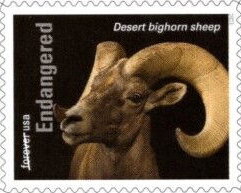Stamp: Desert Bighorn Sheep (Ovis canadensis nelsoni) (United States of America 2023)
Desert Bighorn Sheep (Ovis canadensis nelsoni) (United States of America 2023)
19 May (United States of America ) within release Endangered Species Act, 50 Years (2023) goes into circulation Stamp Desert Bighorn Sheep (Ovis canadensis nelsoni) face value FOREVER No Face Value
| Stamp Desert Bighorn Sheep (Ovis canadensis nelsoni) in catalogues | |
|---|---|
| Colnect codes: | Col: US 2023.05.19-01s |
Stamp is horizontal format.
Stamp from mini-sheet. Face value US$0.63 on day of issue.Also in the issue Endangered Species Act, 50 Years (2023):
- Stamp - Attwater's Prairie Chicken (Tympanuchus cupido attwateri) face value FOREVER;
- Stamp - Black-Footed Ferret (Mustela nigripes) face value FOREVER;
- Stamp - Candy Darter (Etheostoma osburni) face value FOREVER;
- Stamp - Desert Bighorn Sheep (Ovis canadensis nelsoni) face value FOREVER;
- Mini Sheet - Endangered Species face value 20*FOREVER;
- Stamp - Florida Panther (Puma concolor couguar) face value FOREVER;
- Stamp - Golden-Cheeked Warbler (Setophaga chrysoparia) face value FOREVER;
- Stamp - Guam Micronesian Kingfisher (Todiramphus cinnamominus) face value FOREVER;
- Stamp - Key Largo Cotton Mouse (Peromyscus gossypinus allapaticola) face value FOREVER;
- Stamp - Laysan Teal (Anas laysanensis) face value FOREVER;
- Stamp - Lower Keys Marsh Rabbit (Sylvilagus palustris hefneri) face value FOREVER;
- Stamp - Masked Bobwhite Quail (Colinus virginianus) face value FOREVER;
- Stamp - Mexican Grey Wolf (Canis lupus baileyi) face value FOREVER;
- Stamp - Mississippi Sandhill Crane (Antigone canadensis) face value FOREVER;
- Stamp - Nashville crayfish (Faxonius shoupi) face value FOREVER;
- Stamp - Piping Plover (Charadrius melodus) face value FOREVER;
- Stamp - Roanoke Logperch (Percina rex) face value FOREVER;
- Stamp - San Francisco Garter Snake (Thamnophis sirtalis tetrataenia) face value FOREVER;
- Stamp - Thick-Billed Parrot (Rhynchopsitta pachyrhyncha) face value FOREVER;
- Stamp - Vancouver Island Marmot (Marmota vancouverensis) face value FOREVER;
- Stamp - Wyoming Toad (Anaxyrus baxteri) face value FOREVER;
- Mini Sheet - Endangered Species No Die Cut face value 20*FOREVER;
Stamp Desert Bighorn Sheep (Ovis canadensis nelsoni) it reflects the thematic directions:
Animals are multicellular, eukaryotic organisms of the kingdom Animalia (also called Metazoa). All animals are motile, meaning they can move spontaneously and independently, at some point in their lives. Their body plan eventually becomes fixed as they develop, although some undergo a process of metamorphosis later on in their lives. All animals are heterotrophs: they must ingest other organisms or their products for sustenance.
Mammals are any vertebrates within the class Mammalia (/məˈmeɪli.ə/ from Latin mamma "breast"), a clade of endothermic amniotes distinguished from reptiles (including birds) by the possession of a neocortex (a region of the brain), hair, three middle ear bones and mammary glands. All female mammals nurse their young with milk, secreted from the mammary glands. Mammals include the largest animals on the planet, the great whales. The basic body type is a terrestrial quadruped, but some mammals are adapted for life at sea, in the air, in trees, underground or on two legs. The largest group of mammals, the placentals, have a placenta, which enables the feeding of the fetus during gestation. Mammals range in size from the 30–40 mm (1.2–1.6 in) bumblebee bat to the 30-meter (98 ft) blue whale. With the exception of the five species of monotreme (egg-laying mammals), all modern mammals give birth to live young. Most mammals, including the six most species-rich orders, belong to the placental group. The largest orders are the rodents, bats and Soricomorpha (shrews and allies). The next three biggest orders, depending on the biological classification scheme used, are the Primates (apes and monkeys), the Cetartiodactyla (whales and even-toed ungulates), and the Carnivora (cats, dogs, seals, and allies).
Sheep (pl.: sheep) or domestic sheep (Ovis aries) are a domesticated, ruminant mammal typically kept as livestock. Although the term sheep can apply to other species in the genus Ovis, in everyday usage it almost always refers to domesticated sheep. Like all ruminants, sheep are members of the order Artiodactyla, the even-toed ungulates. Numbering a little over one billion, domestic sheep are also the most numerous species of sheep. An adult female is referred to as a ewe (/juː/ yoo), an intact male as a ram, occasionally a tup, a castrated male as a wether, and a young sheep as a lamb.



